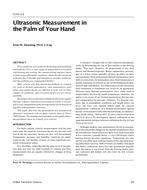Description
Flow conditions vary widely in the heating and ventilating environment. Over a wide range of temperatures associated with heating and cooling, the commissioning engineer meets a whole range of humidity conditions. Add to this the variations of density due to altitude and atmospheric weather conditions and the problems are compounded further. Most velocity and flow measuring methods in common use, such as thermal anemometers, vane anemometers, pitot tubes, and capture hoods, are affected in some way by these changes in conditions, and correction factors are not always available. By using bi-directional times of flight of ultrasonic signals and fast response statistical processing of results, a velocity that is truly independent of the flowing media can be measured together with turbulence intensity. This paper describes the development of a miniaturized ultrasonic instrument with an upper velocity limit of 50 m/s (9999 ft/min). The fundamental technique is also applicable to measurements down to virtually zero velocity.
Units: Dual
Citation: Symposium, ASHRAE Transactions, vol. 107, pt. 2
Product Details
- Published:
- 2001
- Number of Pages:
- 5
- File Size:
- 1 file , 320 KB
- Product Code(s):
- D-7044




